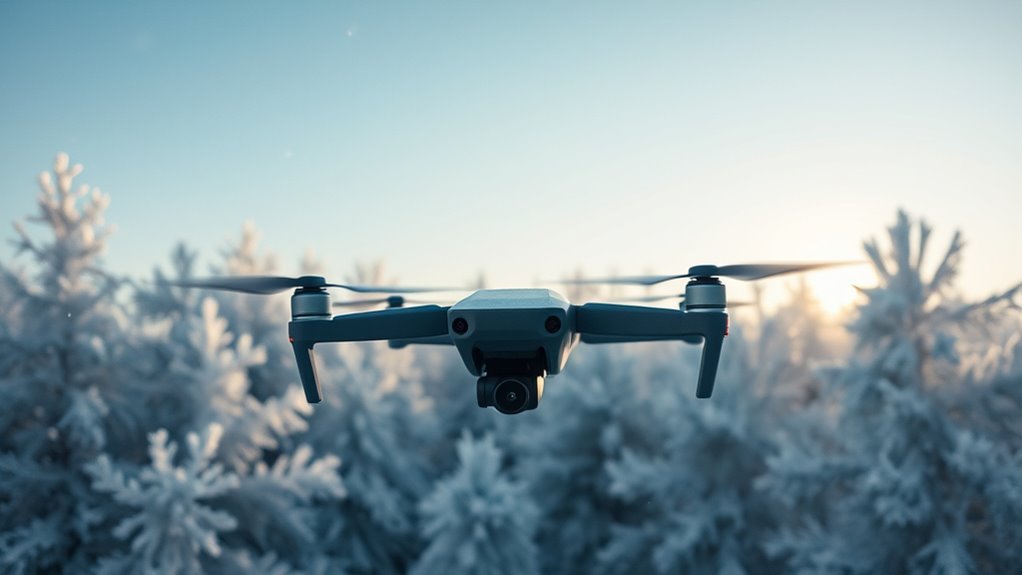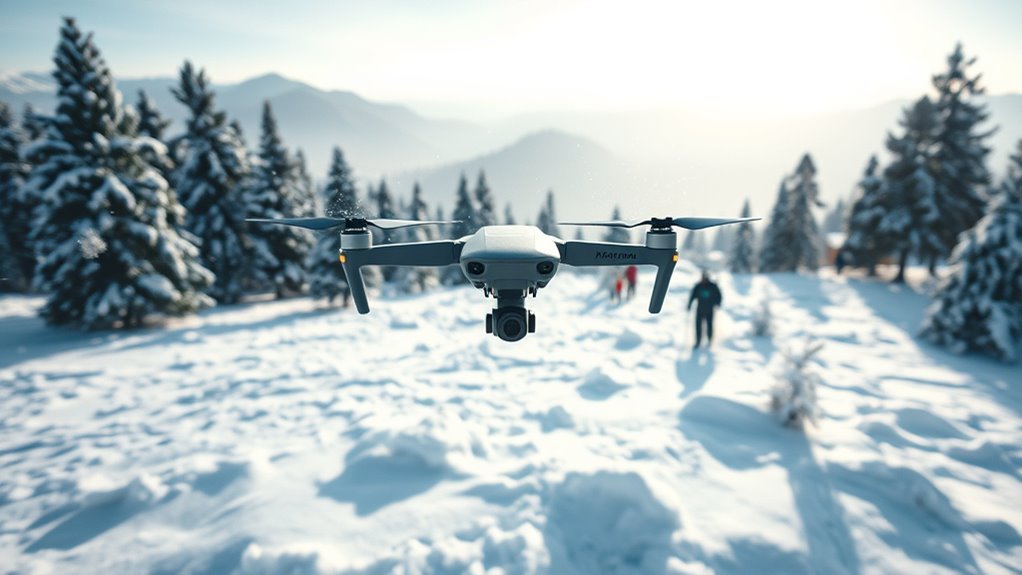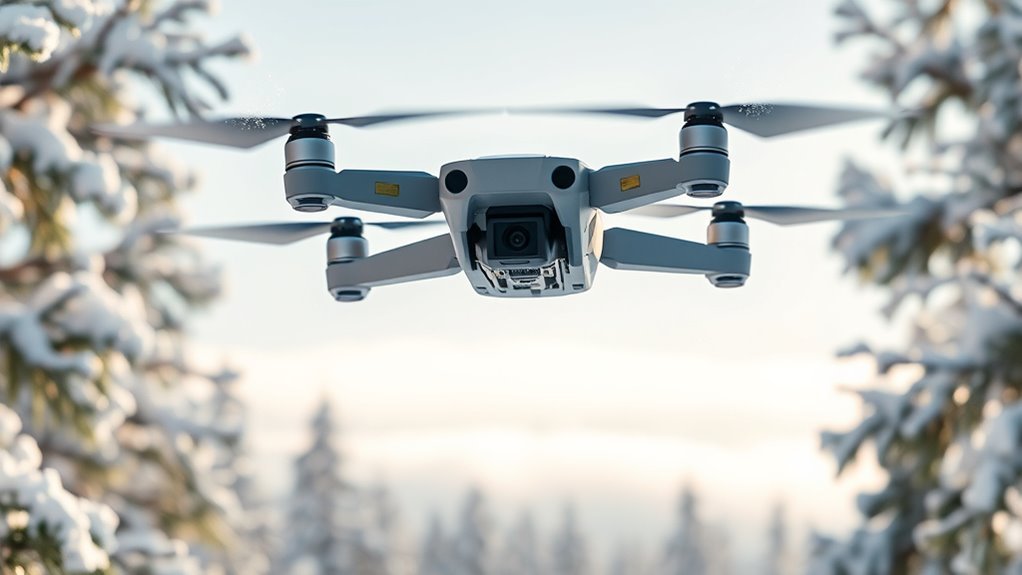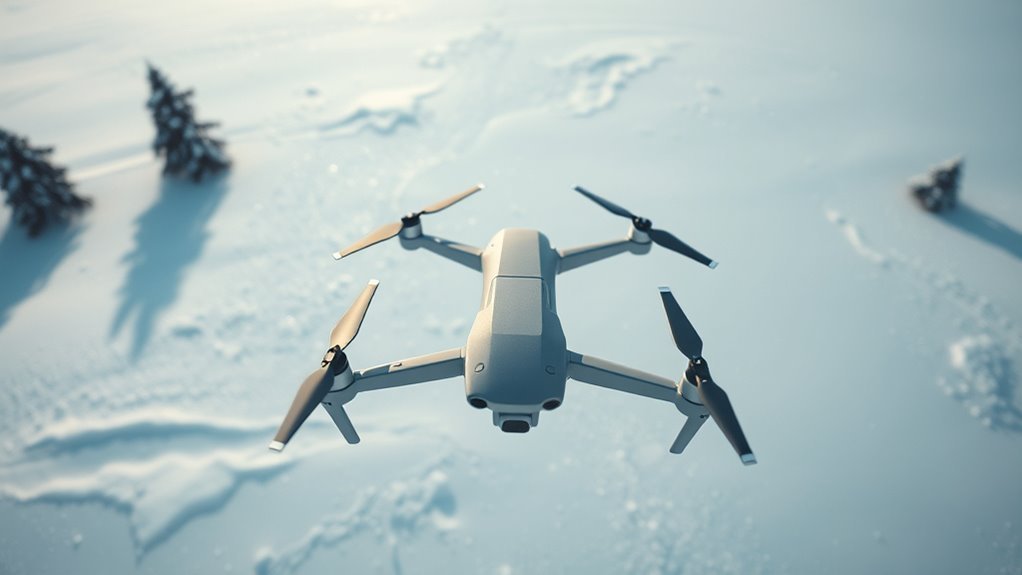To fly drones safely in snowy conditions, first prepare your drone by insulating batteries and pre-warming them to maintain peak performance. Always check weather forecasts for low snowfall and light winds, and use propeller guards to protect blades from snow impact. Keep batteries warm during operation, adjust your camera’s exposure and white balance to handle bright snow, maintain clear visual line of sight, and thoroughly dry and clean your drone after each flight to prevent moisture damage. Explore these tips further to master winter drone operation.
Prepare Your Drone for Cold Weather

Before you fly your drone in snowy conditions, you need to confirm it’s properly prepared for the cold. Cold weather notably impacts battery performance and electronic components. Implement drone insulation by applying specialized thermal wraps around the battery and critical circuitry to retain heat. Use materials designed for low thermal conductivity to minimize heat loss while avoiding added weight that could affect flight dynamics. Additionally, pre-warm your drone’s battery indoors to ideal operating temperature before deployment. Verify all seals and joints are secure to prevent moisture ingress, which can cause malfunctions in freezing temperatures. Proper drone insulation and preparation extend operational time and maintain system responsiveness, giving you the freedom to explore snowy environments confidently without compromising performance or safety. Taking these precise steps is crucial for reliable, uninterrupted flight in cold weather conditions.
Check Weather Conditions Before Flying

Although you’ve prepared your drone for cold weather, you must thoroughly check the weather conditions before flying in snowy environments. Understanding current weather patterns is essential to avoid sudden snowstorms or gusts that could destabilize your drone. Visibility concerns are paramount; reduced sightlines increase the risk of losing orientation or crashing. Use reliable weather apps and local forecasts for precise data.
| Weather Element | Safe Threshold | Impact on Flight |
|---|---|---|
| Snowfall Intensity | Less than 2 mm/hr | Moderate snow can reduce sensor efficacy |
| Wind Speed | Below 15 km/h | Higher speeds impair control |
| Visibility | Minimum 500 meters | Lower visibility risks orientation loss |
Always prioritize safety to maintain your freedom to fly confidently.
Use Propeller Guards to Protect Against Snow

You should equip your drone with propeller guards to shield the blades from snow impact, minimizing damage during flight. Proper installation guarantees the guards don’t interfere with aerodynamics or sensor function. This precaution greatly enhances flight safety in snowy environments.
Snow Impact Protection
Using propeller guards is one of the most effective methods to shield your drone’s blades from snow accumulation and impact. These guards act as a physical barrier, preventing snowflakes and ice from directly contacting the propellers, which can disrupt thrust and stability. When combined with snow sensor technology, your drone can better detect environmental conditions, allowing you to adjust winter flight techniques proactively. This synergy enhances flight safety and maintains aerodynamic efficiency in snowy conditions. Snow impact protection isn’t just about preventing damage; it’s about preserving your drone’s performance and extending operational freedom in harsh environments. By integrating propeller guards with advanced sensor feedback, you guarantee your drone remains responsive and reliable, empowering you to confidently navigate and capture footage in winter’s unpredictable landscapes.
Guard Installation Tips
When preparing your drone for snowy conditions, proper installation of propeller guards is essential to assure ideal protection and performance. These guards shield blades from snow accumulation and impacts, supporting consistent flight during winter flying. To optimize drone maintenance and assure freedom in the air, follow these key installation tips:
- Verify guard compatibility with your drone model to maintain aerodynamic balance.
- Securely fasten guards to prevent vibrations that compromise flight stability.
- Inspect guards regularly for cracks or deformations caused by cold exposure.
- Clean guards after each flight to remove snow residue and prevent ice buildup.
Adhering to these precise steps enhances your drone’s resilience against harsh winter elements, preserving its integrity and enabling you to confidently explore snowy landscapes without hesitation.
Enhanced Flight Safety
Although propeller guards might seem like a simple accessory, they play a critical role in enhancing flight safety during snowy conditions by preventing snow accumulation on blades and minimizing damage from ice impacts. You’ll find that using guards reduces the risk of sudden blade failure, which can compromise stability and control. This precaution aligns with strict flight regulations that emphasize safe operation in adverse weather. Additionally, incorporating propeller guards can safeguard your investment by reducing damage claims, which is essential when considering drone insurance policies that often exclude weather-related incidents. By equipping your drone appropriately, you maintain operational freedom while adhering to regulatory standards and minimizing risk. Prioritize propeller guards to guarantee your drone’s resilience and your compliance during winter flights.
Keep Batteries Warm and Monitor Battery Life
You need to maintain your drone’s battery temperature within ideal ranges to prevent performance drops in cold weather. Use insulated battery warmers or keep batteries close to your body before flight to guarantee they stay warm. Additionally, monitor battery life in real time to avoid sudden power loss during operation.
Battery Temperature Management
Since cold temperatures drastically reduce battery efficiency, managing battery temperature is critical for drone operation in snowy conditions. You need to maintain ideal battery warmth to preserve power output and flight time. Employ battery insulation techniques such as thermal blankets or custom battery insulation sleeves to minimize heat loss. Before flight, keep batteries in a warm environment, and avoid exposing them to extreme cold for extended periods.
Key battery temperature management strategies include:
- Use thermal blankets to retain heat during flight
- Store batteries close to your body before use
- Limit pre-flight exposure to cold air
- Pre-warm batteries with controlled heating pads if possible
Real-Time Battery Monitoring
A reliable real-time battery monitoring system is essential for maintaining ideal battery temperature and evaluating remaining power during snowy flights. You need to keep batteries warm to prevent capacity loss caused by cold temperatures, which directly impacts battery efficiency. Utilize monitoring tools that provide real-time alerts on voltage, current, and temperature fluctuations to avoid unexpected shutdowns. These alerts enable immediate responses, allowing you to land safely or take corrective action before performance degrades critically. Integrate insulated battery compartments with active heating elements controlled by the monitoring system to stabilize thermal conditions. By continuously tracking battery status with precision, you guarantee superior power delivery and extend flight duration despite harsh conditions. This approach gives you the freedom to explore snowy environments confidently, knowing your drone’s battery health is under constant surveillance.
Adjust Camera Settings for Snowy Landscapes
Although snowy landscapes can create stunning visuals, their brightness and reflectivity often challenge standard drone camera settings. To capture crisp, well-balanced footage, you need to adjust your camera exposure and white balance meticulously. Overexposure can wash out details, while incorrect white balance skews colors.
- Lower your camera exposure to prevent blown-out highlights in bright snow.
- Manually set white balance to a cooler temperature to maintain natural snow tones.
- Use histogram feedback to fine-tune exposure and avoid clipping.
- Enable RAW image capture for greater post-processing flexibility.
Fly With Caution and Maintain Visual Line of Sight
One critical rule when flying drones in snowy conditions is to always maintain a clear visual line of sight. This guarantees you retain full visual awareness, essential for effective obstacle navigation amid reduced visibility caused by snow and glare. Without direct visual contact, you risk losing spatial orientation, increasing the chance of collisions with unseen trees, power lines, or terrain features. Stay within a range where your drone remains visible against the snowy backdrop, adjusting your position to keep it in sight at all times. Relying solely on sensors or GPS can be unreliable in snow. By prioritizing visual awareness, you preserve control and react instantly to environmental changes, maximizing your freedom to explore while safeguarding your drone and surroundings.
Dry and Clean Your Drone After Each Flight
Maintaining visual contact with your drone during snowy flights helps prevent accidents, but protecting your equipment after landing is just as important. Proper drone maintenance after each flight guarantees longevity and performance, especially by addressing snow accumulation. Moisture can infiltrate sensitive components, causing corrosion or malfunction. To keep your drone in top condition, follow these steps:
- Gently wipe off snow and moisture using a soft, lint-free cloth
- Use compressed air to remove snow from crevices and motors
- Allow the drone to dry completely in a warm, dry environment before storage
- Inspect electronic connections and battery compartments for residual moisture

